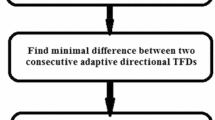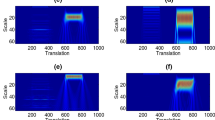Abstract
This paper addresses the problem of estimating the parameters of adaptive directional time–frequency distributions (ADTFDs). ADTFDs locally optimize the direction of the smoothing kernel on the basis of directional Gaussian or double derivative directional Gaussian filter. Conventionally, the parameters of these techniques have to be tuned manually for each particular signal. Global optimization of the parameters fails to provide the desired results when the signal encompasses close or short-duration components. We propose a two-stage algorithm to resolve this issue. As part of the first stage, the length of the smoothing kernel is optimized globally. In the second stage, the parameters which control the shape of the selected smoothing window are optimized, locally. It is shown that the multistage algorithm can result in a time–frequency distribution that has both high resolution for close components and good concentration of signal energy for short-duration signal components. Experimental findings reveal the superiority of the proposed technique over the existing methods in the case of complete signals and its benefits in the case of signals with missing samples.









Similar content being viewed by others
References
S. Ali, N.A. Khan, M. Haneef, X. Luo, Blind source separation schemes for mono-sensor and multi-sensor systems with application to signal detection. Circuits Syst. Signal Process. 36(11), 4615–4636 (2017). https://doi.org/10.1007/s00034-017-0533-6
M.G. Amin, B. Jokanovic, Y.D. Zhang, F. Ahmad, A sparsity-perspective to quadratic time–frequency distributions. Digit. Signal Process. 46, 175–190 (2015). https://doi.org/10.1016/j.dsp.2015.06.011
F. Auger, P. Flandrin, Improving the readability of time–frequency and time-scale representations by the reassignment method. IEEE Trans. Signal Process. 43(5), 1068–1089 (1995). https://doi.org/10.1109/78.382394
M.A. Awal, B. Boashash, An automatic fast optimization of quadratic time-frequency distribution using the hybrid genetic algorithm. Signal Process. 131, 134–142 (2017). https://doi.org/10.1016/j.sigpro.2016.08.017
M.A. Awal, S. Ouelha, S. Dong, B. Boashash, A robust high-resolution time–frequency representation based on the local optimization of the short-time fractional Fourier transform. Digit. Signal Process. 70(Supplement C), 125–144 (2017). https://doi.org/10.1016/j.dsp.2017.07.022
R.G. Baraniuk, D.L. Jones, Signal-dependent time–frequency analysis using a radially Gaussian kernel. Signal Process. 32(3), 263–284 (1993). https://doi.org/10.1016/0165-1684(93)90001-Q
R.G. Baraniuk, P. Flandrin, A.J.E.M. Janssen, O.J.J. Michel, Measuring time–frequency information content using the Renyi entropies. IEEE Trans. Inf. Theory 47(4), 1391–1409 (2001). https://doi.org/10.1109/18.923723
M. Bastiaans, T. Alieva, L. Stanković, On rotated time–frequency kernels. IEEE Signal Process. Lett. 9(11), 378–381 (2002). https://doi.org/10.1109/LSP.2002.805118
B. Boashash, T. Ben-Jabeur, Design of a high-resolution separable-kernel quadratic TFD for improving newborn health outcomes using fetal movement detection. In: 2012 11th International Conference on Information Science, Signal Processing and their Applications (ISSPA), pp. 354–359 (2012). https://doi.org/10.1109/ISSPA.2012.6310574
B. Boashash, S. Ouelha, Designing high-resolution time–frequency and time-scale distributions for the analysis and classification of non-stationary signals: a tutorial review with a comparison of features performance. Digit. Signal Process. (2017). https://doi.org/10.1016/j.dsp.2017.07.015
B. Boashash, Estimating and interpreting the instantaneous frequency of a signal. I. Fundamentals. Proc. IEEE 80(4), 520–538 (1992). https://doi.org/10.1109/5.135376
B. Boashash, Time–Frequency Signal Analysis and Processing, 2nd edn. (Academic Press, Oxford, 2015). https://doi.org/10.1016/B978-0-12-398499-9.00003-0
B. Boashash, S. Ouelha, An improved design of high-resolution quadratic time–frequency distributions for the analysis of non-stationary multicomponent signals using directional compact kernels. IEEE Trans. Signal Process. PP(99), 1–1 (2017). https://doi.org/10.1109/TSP.2017.2669899
B. Boashash, N.A. Khan, T. Ben-Jabeur, Time–frequency features for pattern recognition using high-resolution TFDS. Digit. Signal Process. 40(C), 1–30 (2015)
M. Brajovi, V. Popovi-Bugarin, I. Djurovi, S. Djukanovi, Post-processing of time–frequency representations in instantaneous frequency estimation based on ant colony optimization. Signal Process. 138(Supplement C), 195–210 (2017). https://doi.org/10.1016/j.sigpro.2017.03.022
G. Chen, J. Chen, G. Dong, H. Jiang, An adaptive non-parametric short-time Fourier transform: application to echolocation. Appl. Acoust. 87, 131–141 (2015). https://doi.org/10.1016/j.apacoust.2014.06.018
P. Flandrin, P. Borgnat, Time–frequency energy distributions meet compressed sensing. IEEE Trans. Signal Process. 58(6), 2974–2982 (2010). https://doi.org/10.1109/TSP.2010.2044839
F. Hlawatsch, T.G. Manickam, R.L. Urbanke, W. Jones, Smoothed pseudo-Wigner distribution, Choi–Williams distribution, and cone-kernel representation: ambiguity-domain analysis and experimental comparison. Signal Process. 43(2), 149–168 (1995). https://doi.org/10.1016/0165-1684(94)00150-X
T.K. Hon, A. Georgakis, Enhancing the resolution of the spectrogram based on a simple adaptation procedure. IEEE Trans. Signal Process. 60(10), 5566–5571 (2012). https://doi.org/10.1109/TSP.2012.2208637
D. Jones, R. Baraniuk, An adaptive optimal-kernel time–frequency representation. IEEE Trans. Signal Process. 43(10), 2361–2371 (1995)
D.L. Jones, T.W. Parks, A high resolution data-adaptive time–frequency representation. IEEE Trans. Acoust. Speech Signal Process. 38(12), 2127–2135 (1990). https://doi.org/10.1109/29.61539
N.A. Khan, S. Ali, Sparsity-aware adaptive directional time–frequency distribution for source localization. Circuits Syst. Signal Process. (2017). https://doi.org/10.1007/s00034-017-0603-9
N.A. Khan, B. Boashash, Multi-component instantaneous frequency estimation using locally adaptive directional time frequency distributions. Int. J. Adapt. Control Signal Process. (2015). https://doi.org/10.1002/acs.2583
N. Khan, B. Boashash, Instantaneous frequency estimation of multicomponent nonstationary signals using multiview time–frequency distributions based on the adaptive fractional spectrogram. IEEE Signal Process. Lett. 20(2), 157–160 (2013)
N.A. Khan, M. Sandsten, Time–frequency image enhancement based on interference suppression in Wignerville distribution. Signal Process. 127, 80–85 (2016). https://doi.org/10.1016/j.sigpro.2016.02.027
N. Khan, F. Baig, J.N. Syed, N. Ur Rehman, S. Sharma, Analysis of power quality signals using an adaptive time–frequency distribution. Energies 9, 933 (2016)
J. Lerga, N. Saulig, V. Mozeti, Algorithm based on the short-term Renyi entropy and IF estimation for noisy EEG signals analysis. Comput. Biol. Med. 80(Supplement C), 1–13 (2017)
Z. Liang, X. Duan, X. Li, Entropy Measures in Neural Signals (Springer, Singapore, 2016), pp. 125–166
D. Malnar, V. Sucic, J. O’Toole, Automatic quality assessment and optimisation of quadratic time–frequency representations. Electron. Lett. 51(13), 1029–1031 (2015)
C. Mateo, J.A. Talavera, Short-time Fourier transform with the window size fixed in the frequency domain. Digit. Signal Process. (2017). https://doi.org/10.1016/j.dsp.2017.11.003
W. Mecklenbrauker, F. Hlawatsch, The Wigner distribution: theory and applications in signal processing (Elsevier, Amesterdam, 1997)
M. Mohammadi, A.A. Pouyan, N.A. Khan, A highly adaptive directional time–frequency distribution. SIViP 10(7), 1369–1376 (2016). https://doi.org/10.1007/s11760-016-0901-x
M. Mohammadi, N. AliKhan, A.A. Pouyan, Automatic seizure detection using a highly adaptive directional time–frequency distribution. Multidimens. Syst. Signal Process. (2017). https://doi.org/10.1007/s11045-017-0522-8
S. Ouelha, S. Touati, B. Boashash, An efficient inverse short-time Fourier transform algorithm for improved signal reconstruction by time–frequency synthesis: optimality and computational issues. Digit. Signal Process. 65(Supplement C), 81–93 (2017). https://doi.org/10.1016/j.dsp.2017.03.002
L. Rankine, M. Mesbah, B. Boashash, IF estimation for multicomponent signals using image processing techniques in the time–frequency domain. Sig. Process. 87(6), 1234–1250 (2007). https://doi.org/10.1016/j.sigpro.2006.10.013
T.H. Sang, W.J. Williams, Renyi information and signal-dependent optimal kernel design. In: 1995 International Conference on Acoustics, Speech, and Signal Processing, vol. 2, pp. 997–1000 (1995). https://doi.org/10.1109/ICASSP.1995.480344
N. Saulig, I. Orovi, V. Sucic, Optimization of quadratic time–frequency distributions using the local Renyi entropy information. Sig. Process. 129, 17–24 (2016). https://doi.org/10.1016/j.sigpro.2016.05.025
E. Sejdi, I. Djurovi, J. Jiang, Time-frequency feature representation using energy concentration: an overview of recent advances. Digit. Signal Process. 19(1), 153–183 (2009). https://doi.org/10.1016/j.dsp.2007.12.004
E. Sejdi, I. Orovi, S. Stankovi, Compressive sensing meets time–frequency: an overview of recent advances in time–frequency processing of sparse signals. Digit. Signal Process. (2017). https://doi.org/10.1016/j.dsp.2017.07.016
A. Serbes, L. Durak, Optimum signal and image recovery by the method of alternating projections in fractional Fourier domains. Commun. Nonlinear Sci. Numer. Simul. 15(3), 675–689 (2010). https://doi.org/10.1016/j.cnsns.2009.05.013
L. Stanković, A method for time–frequency analysis. IEEE Trans. Signal Process. 42(1), 225–229 (1994). https://doi.org/10.1109/78.258146
L. Stanković, A measure of some time–frequency distributions concentration. Signal Process. 81(3), 621–631 (2001). (special section on digital signal processing for multimedia)
I. Volaric, V. Sucic, S. Stankovic, A data driven compressive sensing approach for time–frequency signal enhancement. Signal Process. 141(1), 229–239 (2017). https://doi.org/10.1016/j.sigpro.2017.06.013
W.J. Williams, T. Sang, Adaptive RID kernels which minimize time–frequency uncertainty. In: Proceedings of IEEE-SP International Symposium on Time–Frequency and Time-Scale Analysis, pp. 96–99 (1994). https://doi.org/10.1109/TFSA.1994.467355
J. Zhong, Y. Huang, Time–frequency representation based on an adaptive short-time Fourier transform. IEEE Trans. Signal Process. 58(10), 5118–5128 (2010). https://doi.org/10.1109/TSP.2010.2053028
M. Zhu, X. Zhang, Y. Qi, An adaptive STFT using energy concentration optimization. In: 2015 10th International Conference on Information, Communications and Signal Processing (ICICS), pp. 1–4 (2015). https://doi.org/10.1109/ICICS.2015.7459918
Author information
Authors and Affiliations
Corresponding author
Rights and permissions
About this article
Cite this article
Mohammadi, M., Pouyan, A.A., Khan, N.A. et al. Locally Optimized Adaptive Directional Time–Frequency Distributions. Circuits Syst Signal Process 37, 3154–3174 (2018). https://doi.org/10.1007/s00034-018-0802-z
Received:
Revised:
Accepted:
Published:
Issue Date:
DOI: https://doi.org/10.1007/s00034-018-0802-z




